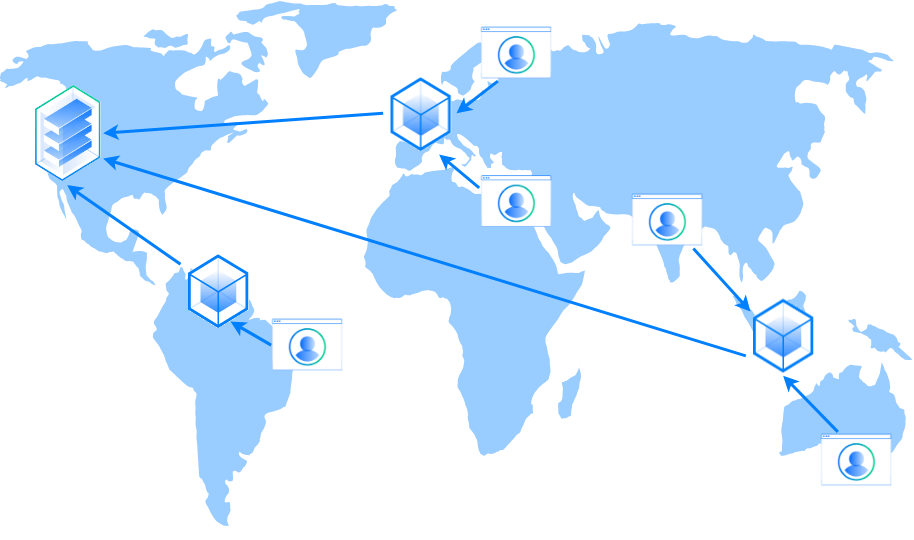CDN - Explanations?
CDN, "content Delivery Network", means "content delivery network", in French. It is a set of servers located in several different places, which are networked by the Internet. The role of CDNs is to quickly distribute the static content of your site or web applications around the world. Increasingly used by webmasters, free CDNs make it possible to handle activity peaks without the servers becoming clogged. This is one of the solutions that will allow your business to gain in agility and speed.
Each individual or professional Internet user expects responsiveness. Poorly optimized sites will therefore be strongly impacted if the loading speed leaves something to be desired. Speed is more important than ever when it comes to SEO. Google heavily penalizes sites that are not optimized for speed. The same is true for DOM load time (the data relates to document parsing statistics), representing the time required for the browser to receive and parse the HTML of the page.
If you use a CDN, you will therefore be able to distribute your content all over the planet. When we talk about content, we think of data from web applications, websites and even streaming media content. Currently, the majority of web traffic is served through CDNs, including traffic from well-known sites like Netflix, Facebook, and Amazon.
CDNs fall into two main types of servers. These are Origin Servers and Edge Servers. Origin servers are responsible for introducing content into the networks. As for the edge servers, they are located in several places to relay the content from the origin servers.

The CDN: how does it work?
The operation of a CDN can be confusing, but when you pay a little more attention, you realize that it is relatively simple. The purpose of using CDNs is to allow your customers to access your content anywhere in the world, and in real time. The Internet user sends a request to the DNS server. The CDN uses a technology to identify the Datacenter closest to the user and whose latency time is short for him.
When the user receives the request, the requested files may not be available in cache. In this case, the CDN fetches them and then sends them back. If the requested documents are available in the cache, they are sent to your users without soliciting the servers. This option allows you to manage peaks and accelerate the speed of your site. Also, if the files are outside of your cache rules, the CDN directs the user's request to your server, so that the latter receives the content of their request.
Note that the files available in the cache have a lifetime. When it expires, the CDN supports its update following the request for documents by a potential visitor. As operations multiply, your site loads faster and the level of bandwidth usage is reduced.
To put it simply, when you are not using a CDN, the request of the user who is in New York, for example, will have to travel a long distance before reaching him, depending on his position in relation to the place of hosting. The absence of a CDN slows down the speed of your website and therefore your positioning in search results. If your site is hosted in France and the user is in Canada, the loading speed will be slow. As you will have understood, the advantage of the CDN no longer needs to be proven. If it allows to reduce the latency time, it is also a key point within the framework of the natural referencing of your site.
Why use a CDN on your website?
Using a CDN has many benefits, including:
Improved site loading time
Using a CDN allows your pages to be displayed quickly, regardless of the browser or mobile device used. Thanks to this first asset, it's a safe bet that you will be able to reduce the bounce rate on your website. When your site is fast, visitors spend more time on it, simply because their browsing experience is better. As a reminder, among the criteria taken into account by Google to reference a website, there is obviously the loading time of the pages. In this sense, using CDNs will be to your advantage.
Reduced bandwidth costs and increased content redundancy
Caching allows CDNs to limit the amount of files an origin server has to serve. This reduces hosting costs for website owners. As for content redundancy, high traffic or hardware defects can cause a website to malfunction.
Reinforcement of website security
Using a CDN provides better security on a website. It limits the profusion of DDoS (Distributed Denial of Services) attacks. By using a CDN, you will be able to quickly identify attacks against your site and block the IP addresses of unwanted people (hackers). Even if it is sometimes accompanied by other security solutions, this alternative limits the risk of disruption to your website.
The Best Free CDNs
CloudFlare
Cloudflare is a company that offers a content distribution network. Arrived on the market in July 2009 in San Francisco in the United States, its CDN formula offers completely free services. It is one of the major known CDN providers. Very popular for its quality and the performance of its media, it has 115 datacenters spread throughout the territory, Cloudflare also provides DDoS protection to secure your website. If you are looking for a completely free CDN to speed up the loading time of your web pages, you can use this Clouflare.
Incapsula
If you're looking for a CDN with the security options, but already enjoy using another CDN, Incapsula Content Delivery network can be a strong ally. For the protection of your web files. You can therefore use this CDN in addition to other CDNs to boost your performance, just like many companies like Linkedin, which has 3 CNDs to its credit. eBay meanwhile has two. Besides protecting your website from data leaks, this CDN provides redundancy and speeds it up.
JetPack
In its comprehensive collection of services, JetPack offers a free CDN. This allows users to enjoy a full experience of ultra-fast data transmission. Its CDN server called Photon goes through a plug-in if you want to integrate it into WordPress.
Swarmify
Swarmify, also known as SwarmCDN, is a paid CDN. However, it offers a free version to give its users the opportunity to get feedback on the features available as a free option. With the free Swarmify CDN, you will be able to benefit from 10 GB bandwidth for images essentially. This CDN is based on a Peer to peer (P2P) approach, in order to save bandwidth usage.




